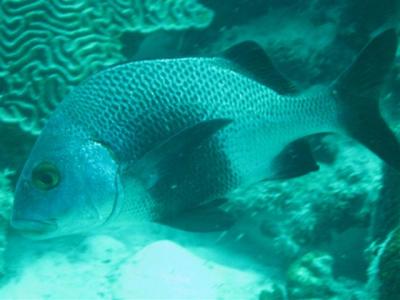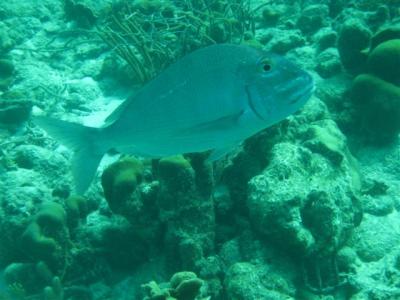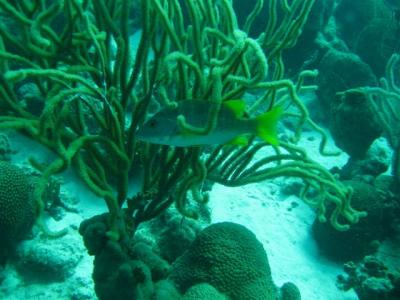We again talked Jack and Mike into taking us diving. This time we headed north to a wreck dive we had heard about. The wreck is in front of a dive center, and there was no mooring to tie to. We asked the dive center if we could tie up to their pier. They told us it isn’t a very good dive and suggested we go to a better wreck dive down south. Apparently, it was just a small wooden boat that is almost totally disintegrated now.
We motored over to the exact spot that the dive guy said the wreck was located and Jack stuck his face in the water. He agreed it wasn’t worth exploring. Since we were already up north, we decided to go to a nearby site that sounded especially nice. It is called Class Bottom. We tied up to the buoy. There were a lot of fish right under dinghy, especially sergeant fish and the little gray chromium fish. A good sign indeed!
Jack snorkeled around the general area, but once again, said it really wasn’t a very good snorkeling spot. Mike, Christi and Eric dove it and thought it was a great dive site. After we jumped in, we headed south to the next dive site marker, called Andrea I. The visibility here is the worst of all the sites we have been to in Bonaire, but it is still good. The visibility everywhere else has been phenomenal. There is very little trash around, and we expected a site farther away from town to be more pristine.
Once again, Mike brought his camera, so we can show you some of the fish we saw. The first is called a black margate. The second is called a jolthead porgy. The third is called a schoolmaster. The schoolmaster is in a giant sea rod soft coral. The three mounds in the foreground (left, right, middle) are great star hard coral, which Christi thinks looks like cells.



This spot has the best coral we have seen yet. There isn’t a lot of color, with just a few purple tube sponges and the rest all shades of brown. But the coral is vibrant and healthy, big and abundant. We saw some staghorn and elkhorn coral, which we haven’t seen much of anywhere else here in Bonaire. There are lots of sea rod and sea plum soft corals, and really tall, like a good 6 or 7 feet tall. There was also quite a bit of branching vase sponge, which is similar to tube sponges but with a smooth exterior instead of bumpy and uneven exterior. There were a few anemones, too.
There isn’t as much fish, or as many varieties, as behind our boat, but there are still lots and lots of fish to look at. In addition to the ones pictured above, we saw honeycomb cowfish, porcupine fish, enormous French angelfish, a large great barracuda, a white spotted file fish, a spotted drum, a few types of parrotfish, sand divers, rock hinds, Atlantic spadefish, scrawled filefish, queen angelfish, rock beauties, trumpetfish, and banded butterfly fish. We did see one new species for us, called a cornet fish, which is similar to a trumpet fish but longer and skinnier.
We are most proud to report that we managed to find a spotted scorpion fish, which look like rocks and are very difficult to discern. And we spotted a small golden tail moray eel. We saw a couple of sea slugs, which reminds us that we haven’t seen many here in the Caribbean. We usually saw tons of them on all our South Pacific dives. Of course, embedded in the rocks and coral were many Christmas tree worms and split crown feather duster worms. And there were a couple basket stars around, as well.
After the dive, we headed back to Kosmos. Christi worked cleaning the waterline and the bottom until both tanks were completely out of air. Then it was time for yet more errands. Our mail had brought us a new round of reminders about life responsibilities at home that never go away. One of the nice things about staying put, having internet access and reliable mail service is that we can deal with them effectively. In many places in the world, taking care of these things can be incredibly difficult to do.
We assumed that the package from Nordhavn had arrived yesterday, too, but was held up in customs and that we needed to go and pick it up in person. We called Nordhavn to get the tracking number for the package so that we could track it on line to confirm its arrival. We were most unhappy to find that they hadn’t sent the package yet. The parts guy didn’t seem to think we needed it right away and that he could send it at any time. We were frustrated and cancelled the order.
While we were out running errands, we went by the marina to pick up our other propane tank. We met a couple that has the same Bayliner Cierra 28 model that we used to own. It turns out they just got it and were learning how to use it, so Eric showed them how to use a few of the non-intuitive things on the boat. We had a nice visit with them. They invited us over for dinner this weekend, but we’re leaving in a couple days, so we couldn’t accept the offer. It is neat when we make friends with the locals.
We wanted to comment on the local language. It is called Papiamento and is a mix of Dutch, English, Spanish, and Portuguese, with some Indian and African words, too. We’re not sure exactly how Portuguese came to be part of the mix. Papiamento is funny to listen to because you can almost follow what they are saying. There are distinctive English and Spanish words. Some of the Portuguese words sound kind of like French words, such as “bon” for good, so we can pick those out. Some Dutch words sound sort of similar to English words, so sometimes we can pick out the Dutch words, too. Of course, there are plenty of indistinguishable words in the mix, but overall, we can sort of half follow what the locals say to one another. In addition to Papiamento, Dutch is also an official language. Everybody, and we mean everybody, speaks English and most people seem to speak Spanish, too. Quite the multi-lingual society.
